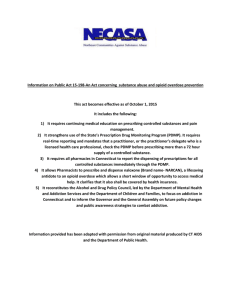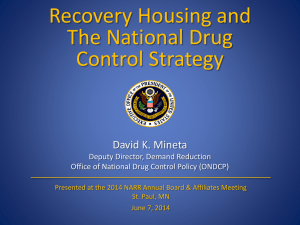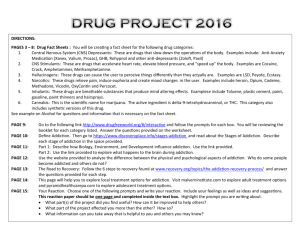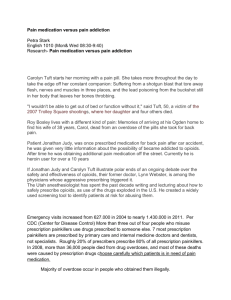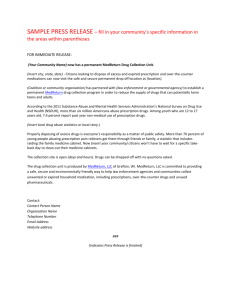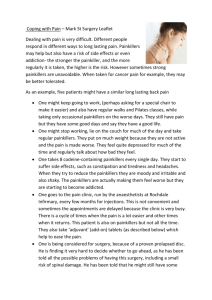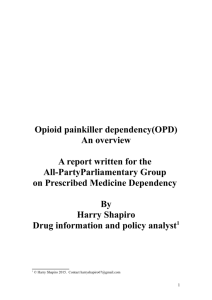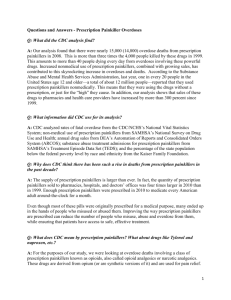Report vision
advertisement
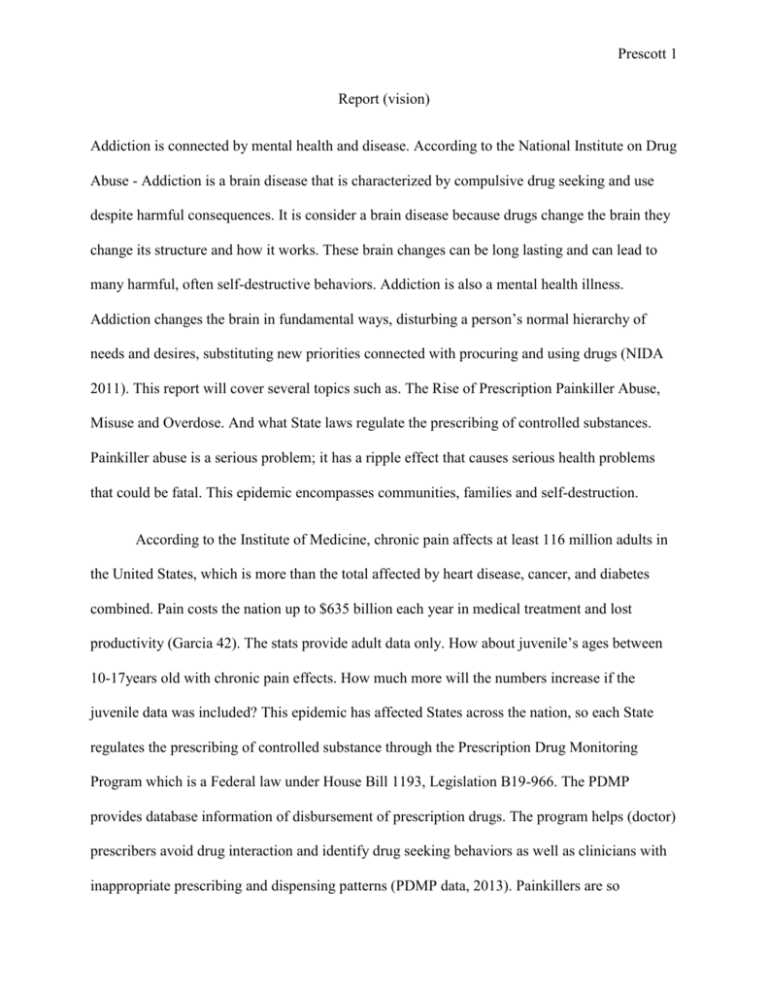
Prescott 1 Report (vision) Addiction is connected by mental health and disease. According to the National Institute on Drug Abuse - Addiction is a brain disease that is characterized by compulsive drug seeking and use despite harmful consequences. It is consider a brain disease because drugs change the brain they change its structure and how it works. These brain changes can be long lasting and can lead to many harmful, often self-destructive behaviors. Addiction is also a mental health illness. Addiction changes the brain in fundamental ways, disturbing a person’s normal hierarchy of needs and desires, substituting new priorities connected with procuring and using drugs (NIDA 2011). This report will cover several topics such as. The Rise of Prescription Painkiller Abuse, Misuse and Overdose. And what State laws regulate the prescribing of controlled substances. Painkiller abuse is a serious problem; it has a ripple effect that causes serious health problems that could be fatal. This epidemic encompasses communities, families and self-destruction. According to the Institute of Medicine, chronic pain affects at least 116 million adults in the United States, which is more than the total affected by heart disease, cancer, and diabetes combined. Pain costs the nation up to $635 billion each year in medical treatment and lost productivity (Garcia 42). The stats provide adult data only. How about juvenile’s ages between 10-17years old with chronic pain effects. How much more will the numbers increase if the juvenile data was included? This epidemic has affected States across the nation, so each State regulates the prescribing of controlled substance through the Prescription Drug Monitoring Program which is a Federal law under House Bill 1193, Legislation B19-966. The PDMP provides database information of disbursement of prescription drugs. The program helps (doctor) prescribers avoid drug interaction and identify drug seeking behaviors as well as clinicians with inappropriate prescribing and dispensing patterns (PDMP data, 2013). Painkillers are so Prescott 2 addictive and what is being done to combat this epidemic. Each State and government has programs implemented to educate communities as to the dangers of painkillers. I’ve learned the genetic make-up and the ingredient in painkillers are highly addictive. The background into pain medicine is the narcotic Opium; its chemical ingredient comes from morphine molecules which are compared to heroin. Painkillers relieve pain and can cause euphoria or intense feeling of pleasure as well as a sense of well-being, calmness and drowsiness. Opiates act upon specific receptors in the brain and spinal cord in order to ease the pain and reduce the emotional response to pain (NIH). With this knowledge we can see how opiates affect receptors in the brain; it blocks the emotional response to pain and because it’s a narcotic, it creates pleasurable and euphoric calm feeling thus making it highly addictive (Garcia 42, 43). Furthermore research shows the rise of painkiller abuse, misuse and overdose has increase thirty-five percent since 2010. Painkiller overdose deaths killed nearly 15,000 people each year. Since 2009 opioid painkiller deaths has increased three times as much as cocaine and heroin overdose deaths (CDC). Painkiller addiction is a disease and mental illness. Pain affects millions of people each year and without proper education and knowledge as to what opioid painkillers can do; people are at high risk and usually take inadequate steps that led to misuse, abuse and overdose death. Another step to combating this epidemic, are health programs funded by the State and Government. Prescription drug monitoring programs vary by State. The drug monitoring programs provide data information as to how prescribers and dispensers are regulated. New York State leads the Nation in prevention of painkiller abuse by providing a law stating “Every practitioner shall consult the prescription monitoring program registry prior to prescribing or dispensing any controlled substance listed on schedule II, III or IV for the purpose of reviewing a patient controlled substance history” (New York Assembly bill 10623, 2012). Prescott 3 Pain Clinics are also monitored by each State. Pain clinics prescribe a high limit of prescription painkillers and some clinics are known as “pill mills” because of its distinguish prescribing practice such as nonexistent patient exams, the absence of health care providers, and cash only payments and operations (Garcia 42,43). Each State provides laws that oversee pain clinics through registration or licensure, requiring State inspection of pain management facilities and the owners is a licensed physician who meets specific education and training criteria in pain management (NIDA, 2011). Nevertheless you can see efforts made by State and Government programs to prevent the misuse of painkillers. It’s a serious challenge and if health professions, physicians, and pain clinics can work together, strategies can be develop in order to combat this epidemic. In summary you can see how serious the painkiller addiction is. It is a disease which affects both the body and mind, just as mental health illness encompass the mind and body. The ripple effects from this epidemic have the attention of State and Government agencies. Painkiller addictions are powerful and can take over your life before you know it. Overcoming addiction is a can be a long, painful, and costly process. There are many tools on your road to recovery, programs, treatment centers, counseling is aids to help support and heal you. Prescott 4 Works Cited Michael Gross. “Self, Medicated.” American Journal of Public Health: August 2014, Vol. 104, No. 8, pp. 1348-1348. doi: 10.2105/AJPH.2014.302091 Murphy, Samantha. "The People who Are Addicted to Addiction." New Scientist 215.(2012): 36-39. Science Direct. Web. 8 Oct. 2014. Painkillers [Electronic Resource (Video)] : Numbing The Mind / ARTE France. n.p.: New York, N.Y. : Films Media Group, [2006], c2005., 2006. SLCC Libraries Catalog. Web. 8 Oct. 2014. Colvin, Rod. “Overcoming Prescription Drug Addiction.” A Guide To Coping And Understanding / Rod Colvin. n.p.: Omaha, Neb. : Addicus Books, c2008., 2008. SLCC Libraries Catalog. Web. 8 Oct. 2014. Garcia, Andrea M. "State Laws Regulating Prescribing Of Controlled Substances: Balancing The Public Health Problems Of Chronic Pain And Prescription Painkiller Abuse And Overdose." Journal Of Law, Medicine And Ethics: A Journal Of The American Society Of Law, Medicine And Ethics 41.1 (2013): 42-45. Philosopher's Index. Web. 8 Oct. 2014. National Institute of Drug Abuse (2011). Comorbidity: “Addiction and other Mental Disorders”. From http://www.drugabuse.gov/publications/drugfacts/comorbidity-addiction-other-mentaldisorders on October 12, 2014

